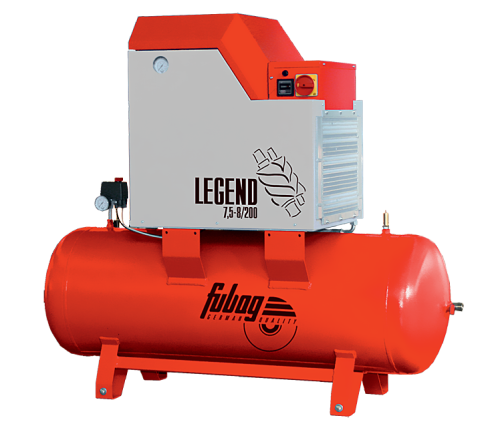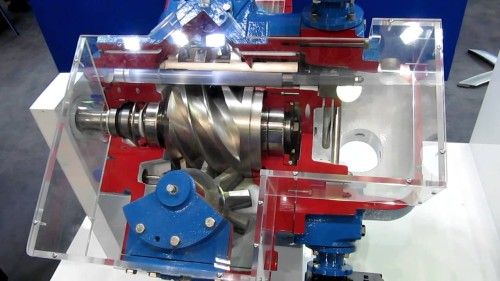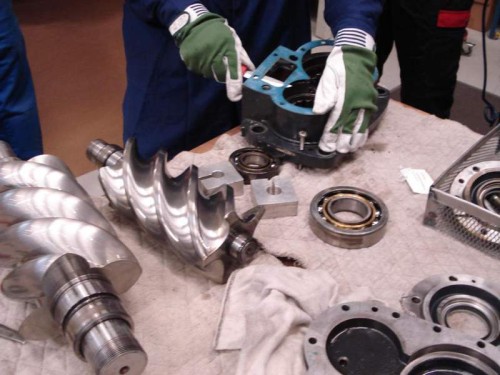The screw compressor belongs to one of the most efficient types of equipment, due to which the compressed air is obtained in various industries (engineering, electronic, woodworking, pharmaceutical, furniture). On the features of the compressors, possible malfunctions and methods of repairing equipment and will be discussed in our article.
Content
Composite parts of equipment
Screw equipment consists of the following main elements:
- Cases. In most cases, it is made of steel, which is covered with non-combustible, noise absorbing and oil resistant material.
- The screw block of the compressor (it is also called the screw pair), which is the "heart" of the equipment. It consists of two high-tech rotors that are located in the inside of the case.
- Three types of pipelines: oil, air and air-butter.
- The suction valve. It regulates the capacity of the unit by a pneumatic control.
- Suction air filter. It is intended for cleaning the air that enters the compressor. Actually it consists of two filters that are installed in front of a suction valve assembly on the housing (where the intake air).
- Belt transmission. Provides a certain speed of rotation of the rotors (the higher, the better performance of equipment) by combining the "effort" two pulleys disposed on the engine and the screw pair. Powerful compressors are equipped with gearbox or clutch Direct drive.
- Motor. Through a belt drive operates the screw pair.
- Fan. Promotes entering air flow and cooling of the motor and a screw pair.
- Thermostat. This element of the screw compressor in the circuit acts as a temperature regulator. Thanks to a thermostat with temperature over 72ºS oil passes through the cooling radiator.
- Oil filter. Cleans the oil before it enters the screw pair.
- Oil separator. Metal tank, in the middle part of which is located a partition with openings. Process for cleaning of air from oil takes place by creating a centrifugal force.
- Oil cooler. It cools the oil after separation from the compressed air.
- End air cooler. It cools the compressed air before it is fed to the consumer as well as the output equipment makes a temperature higher than the temperature at 10-15ºS ambient air.
- the electronic control unit. Controls the operation of the screw compressor and transmits the display equipment performance.
- Pressure switch. Specifies the maximum pressure of the compressor. The latest models of the relay equipment is missing, because it uses an electronic control system.
- The safety valve. When the pressure in the oil separator of the maximum possible value is its automatic actuation.
Benefits and working principle
The enormous demand for screw compressors due to the fact they have numerous advantages compared to the use of a centrifugal or reciprocating equipment. The main ones are:
- easy installation and connection;
- continuity;
- maximum reliability;
- long operational period;
- the presence of small operating costs;
- obtaining almost ideal for clean air;
- minimum power consumption per 1 m³ of air;
- low noise figure;
- availability of automatic control systems.
Based on the screw compressor device, its principle of operation is as follows:
- when passing by the suction valve and air filter, air flows fall into the screw block;
- the air is mixed with oil, which circulates along a closed space;
- by exposure to the screw block, the mixture of oil and air falls into the oil separator;
- the air is separated from the oil and is sent to the compressor outlet;
- oil in a small or large circle through the oil cooler (depending on the temperature of the material) arrives back into the screw unit;
- running the screw block occurs with the motor;
- automatic shutdown (or inclusion) is performed using a pressure switch.
It should be noted that the oil in screw equipment performs several functions:
- creates an oil film;
- warm heat;
- distributes air flows;
- provides a gap between the rotors of the screw block;
- lubricates the bearings of the working elements.
Causes of faults and ways to eliminate them
In the process of operation of the equipment, you can face it breakdown. You have to resort to repair of screw compressors. The most common equipment malfunctions include:
- the compressor does not turn on or restarted;
- the unit does not receive compressed air;
- low equipment performance;
- excessive consumption and oil leakage;
- involuntary opening of the safety valve;
- turning off the compressor thermostat;
- high blood pressure;
- circuit breaker operation.
The compressor does not turn on, not restarted, does not receive compressed air, is characterized by low performance
The main reason for the bad power on the equipment is too low air temperature. You just need to warm the room in which the compressor is located, and everything will be fine.
The unit is not restarted due to poor closure of the suction valve. It must be removed and cleaned. In some cases, it will be needed to replace the elements.
The absence of compressed air in the output opening of the compressor indicates the closure of the regulator. It is possible to fix the problem by checking the pressure relay, which must be powered by the electromagnetic valve associated with the regulator.
With the closing of the regulator is connected, in most cases, and low unit capacity. But in this case, the cause of failure is pollution control. To eliminate this, the suction filter is removed, opened and cleaned regulator. BEST MODE - dismantling regulator with its subsequent purification.
Excessive consumption and oil leak
The causes of excessive oil consumption may include:
- broken oil separator filter;
- leaky seal oil separator filter.
In both cases, problems can be solved by replacing the seals, or the filter itself.
Oil leaking from the suction filter suggests that the regulator is not closed or excessively high pressure system. In the first case, check the functioning of the regulator and solenoid valve. In the second case, in addition to inspection and control valve, pressure gauge should be checked.
The reason for the oil to reach the control panel is an oil leak through the unit flange. This problem is eliminated by replacing the sealing ring compressor.
Opening of the safety valve, high pressure operation of the thermostat and the circuit breaker
The reason for the opening of the safety valve may be clogged filter separator. It should check the pressure difference between the separator tank and the conduit with compressed air. If there is a need, then the filter should be replaced.
In the presence of pressure that exceeds the maximum set value, the controller must check. There may be no team on its closure. Make sure that the solenoid valve is turned off.
Disabling compressor thermostat is the case:
- fault thermal expansion valve;
- insufficient amount of oil;
- fault drain system.
These problems are solved accordingly as follows:
- valve replacement is performed;
- the oil is filled to the desired level;
- checked by the check valve and piping decanted oil.
Tripping the circuit breaker associated with:
- overheating of the electric motor;
- insufficient voltage in the network;
- excessively high temperature in the room.
In case of overheating of the electric motor checked relays and heat from it. In the normal heat removal reset button is pressed and is carried out of the compressor restarts.
The same actions are manufactured and in the presence of insufficient voltage in the network and high room temperature. The only difference is to pre-check the voltage and ensuring high-quality ventilation, respectively.
Video to troubleshoot the screw compressor:
https://www.youtube.com/watch?v\u003dnpfittFrz9s.

























When you need repair to such equipment, consider that its time has expired from the pneumatic engineering there were no such problems